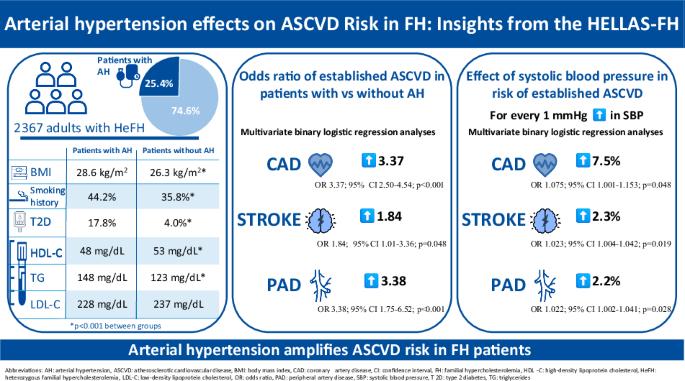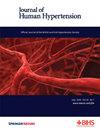血脂水平之外:揭示家族性高胆固醇血症中的高血压因素。HELLAS-FH登记处。
IF 3.4
4区 医学
Q2 PERIPHERAL VASCULAR DISEASE
引用次数: 0
摘要
动脉高血压(AH)和家族性高胆固醇血症(FH)是动脉粥样硬化性心血管疾病(ASCVD)的主要危险因素。AH和FH共存对ASCVD风险的放大程度尚不清楚。我们的目的是探讨AH对FH患者ASCVD患病率的影响。这是来自HELLAS-FH登记处的横断面分析。对2367例成人杂合子FH进行了研究。其中602例(25.4%)患者患有AH。与没有AH的患者相比,AH患者更有可能有额外的ASCVD危险因素(糖尿病、吸烟、肥胖、甘油三酯升高和高密度脂蛋白胆固醇水平降低)。AH患者有较高的冠状动脉疾病(CAD)患病率(44% vs 14%, p本文章由计算机程序翻译,如有差异,请以英文原文为准。

Beyond lipid levels: unraveling the hypertensive factor in familial hypercholesterolemia. The HELLAS-FH registry
Arterial hypertension (AH) and familial hypercholesterolemia (FH) are major risk factors for atherosclerotic cardiovascular disease (ASCVD). The extent to which the coexistence of AH and FH amplifies the ASCVD risk is not well known. We aimed to explore the effect of AH on the prevalence of ASCVD in patients with FH. This was a cross-sectional analysis from the HELLAS-FH registry. A total of 2367 adults with heterozygous FH were studied. Out of these, 602 (25.4%) patients had AH. Patients with AH were more likely to have additional ASCVD risk factors (diabetes, smoking, obesity, elevated triglycerides and reduced high-density lipoprotein cholesterol levels) compared with patients without AH. Patients with AH had significantly higher prevalence of established coronary artery disease (CAD) (44 vs 14%, p < 0.001), premature CAD (39 vs 13%, p < 0.001), stroke (6 vs 2%, p < 0.001), and peripheral artery disease (6 vs 1%, p < 0.001) compared with those without after adjustment for major ASCVD risk factors. Systolic blood pressure (SBP) was significantly associated with increased odds of established CAD per 1 mmHg [odds ratio (OR) 1.075; 95% CI 1.001–1.153; p = 0.048], stroke (OR 1.023; 95% CI 1.004–1.042; p = 0.019) and PAD (OR 1.022; 95% CI 1.002–1.041; p = 0.028), while diastolic blood pressure showed no significant association with these outcomes. In conclusion, AH is associated with higher ASCVD risk factor burden and increased prevalence of ASCVD in patients with FH.
求助全文
通过发布文献求助,成功后即可免费获取论文全文。
去求助
来源期刊

Journal of Human Hypertension
医学-外周血管病
CiteScore
5.20
自引率
3.70%
发文量
126
审稿时长
6-12 weeks
期刊介绍:
Journal of Human Hypertension is published monthly and is of interest to health care professionals who deal with hypertension (specialists, internists, primary care physicians) and public health workers. We believe that our patients benefit from robust scientific data that are based on well conducted clinical trials. We also believe that basic sciences are the foundations on which we build our knowledge of clinical conditions and their management. Towards this end, although we are primarily a clinical based journal, we also welcome suitable basic sciences studies that promote our understanding of human hypertension.
The journal aims to perform the dual role of increasing knowledge in the field of high blood pressure as well as improving the standard of care of patients. The editors will consider for publication all suitable papers dealing directly or indirectly with clinical aspects of hypertension, including but not limited to epidemiology, pathophysiology, therapeutics and basic sciences involving human subjects or tissues. We also consider papers from all specialties such as ophthalmology, cardiology, nephrology, obstetrics and stroke medicine that deal with the various aspects of hypertension and its complications.
 求助内容:
求助内容: 应助结果提醒方式:
应助结果提醒方式:


